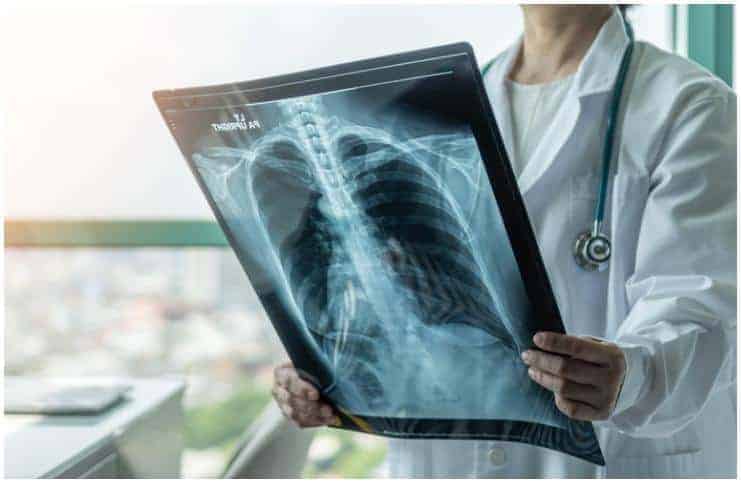Basilar atelectasis (BA) is a condition where either a part of the lung or the whole lung collapses. It has a few causes, however, it can be managed to help the sufferers breathe more easily.
It affects both the right and the left lung and usually isn’t life-threatening. Nevertheless, if it has an impact on a large area of the lungs, particularly in a small child, baby, or an individual who has another lung problem, this condition can be fatal if not treated correctly and quickly.
This condition is usually confused with pneumothorax, another condition in which air leaks into the space between your chest and lung. Additionally, pneumothorax is one of the causes of BA.
It can be chronic or acute:
- chronic – described by the widening of the bronchi as well as a complex mixture of scarring and infection of the lungs;
- acute – it is mainly notable only for airlessness and is characterized by recently collapsed lungs.
Symptoms
Symptoms of this lung condition include rapid shallow breathing, reduced sounds during breathing, difficulty in expanding the chest while breathing (particularly in the supine position), excessive breathlessness, cough, chest pain, a bluish tinge to the toes or lips (caused by cyanosis), and low-grade fever.
Causes
Anesthesia – most patients who undergo surgery have some level of this condition arising from the use of a substance for anesthesia, which temporarily will put you to sleep and can decrease your natural urge to cough and effort to breathe.
Blood Clot – it can cause this problem if the blood enters the inside of the lungs and escapes the bloodstream. This is commonly the result of a blunt force trauma to the chest.
Tumors in the lungs (malignant or benign) – a lung tumor is usually the result of abnormal rates of cell death or cell division in the airways that lead to the lungs or in lung tissue.
Damage to muscles and nerve which control breathing – it may prevent deep breathing, coughing, or yawning.
Drugs – large doses of sedatives or opioids can decrease considerably deep breathing.
Pneumonia – it is an infection in one or both lungs that can be caused by viruses, harmful bacteria, or fungi. If you have chronic underlying lung diseases or your pneumonia is severe, you may have notable trouble breathing in enough oxygen.
Pressure on the lung (called a pleural effusion) – it can be caused by a buildup of fluid between the lungs and the ribs.
Chest trauma – this type of injury can result from a car accident or a fall and can make you avoid taking deep breaths, that can lead to this condition.
Treatment of Bibasilar Atelectasis
Your doctor may prescribe you Acetadote, which is a medicine used to thin the mucus, or Foradil, a prescription medicine that can help to expand the bronchial tubes. If a lung tumor is the cause of this condition, surgery may be required to remove it.
Moreover, the use of continuous positive pressure may also be beneficial in some individuals who have hypoxemia (low oxygen levels) after surgery or are too weak to cough.
Prevention
Quit Smoking
Quitting smoking cigarettes is proven to reduce the risk of developing this lung problem, particularly in sufferers of chronic obstructive pulmonary disease.
Also, according to research, quitting smoking tobacco about 2 months before surgery lowers the risk of postoperative BA. More importantly, you will give a boost to your overall health, especially the immune system, making it easier for the human body to fight off the flu and colds.
Lose Extra Weight
Being obese or overweight increases your chances of various conditions and diseases. For example, the more you weigh, the more inclined you are to suffer from high blood pressure, heart disease, gallbladder disease, type 2 diabetes mellitus, certain cancers, or sleep apnea.
Moreover, individuals who are carrying unnecessary weight are at greater risk of developing this lung condition.
Incentive Spirometer
After surgery, BA can be prevented by the use of an incentive spirometer. This device encourages you to breathe in slowly and deeply as well as it measures how fast you’re breathing in and how much air you are actually breathing in.
Physical Exercise
Although many associate regular physical exercise with promoting a healthy heart or losing weight, according to recent research, moderate physical exercise can also improve the quality of life for people with a lung condition.
Any type of physical activity counts as physical exercise and includes – swimming, running, bowls, cycling, lifting weights, tennis, or walking.
Tai Chi
Tai chi, also known as “medication in motion” or “meditation in motion,” is a gentle, meditative exercise that employs focused internal awareness, visualization, detailed regimens of flowing circular movements, breathing techniques, and weight and balance shifting.
For sufferers with chronic lung problems, like – pulmonary fibrosis (lung tissue becomes scarred and damaged) or COPD, practicing this method decreases feelings of breathlessness and improves the overall quality of life.
Foods That Promote Lung Health
What we eat and drink may not directly affect the health of our lungs. However, nutrition indirectly touches the lungs through the cardiovascular system. Foods to include in your diet are ginger, broccoli, turmeric, cauliflower, peppers, cabbage, grapefruit, apple, oranges, mangoes, papayas, carrots, walnuts, almonds, apricots, flax seeds, and chia seeds.
READ THIS NEXT: Precordial Catch Syndrome
References http://www.nhs.uk/Livewell/smoking/Pages/Betterlives.aspx https://www.health.harvard.edu/staying-healthy/the-health-benefits-of-tai-chi
